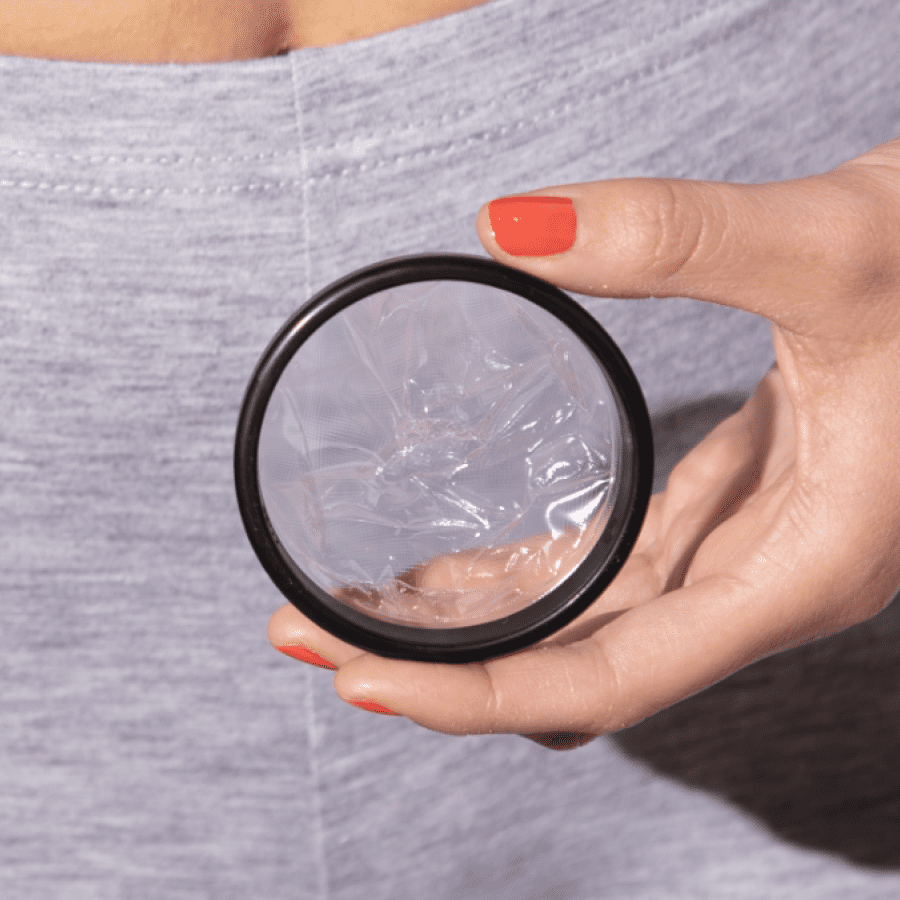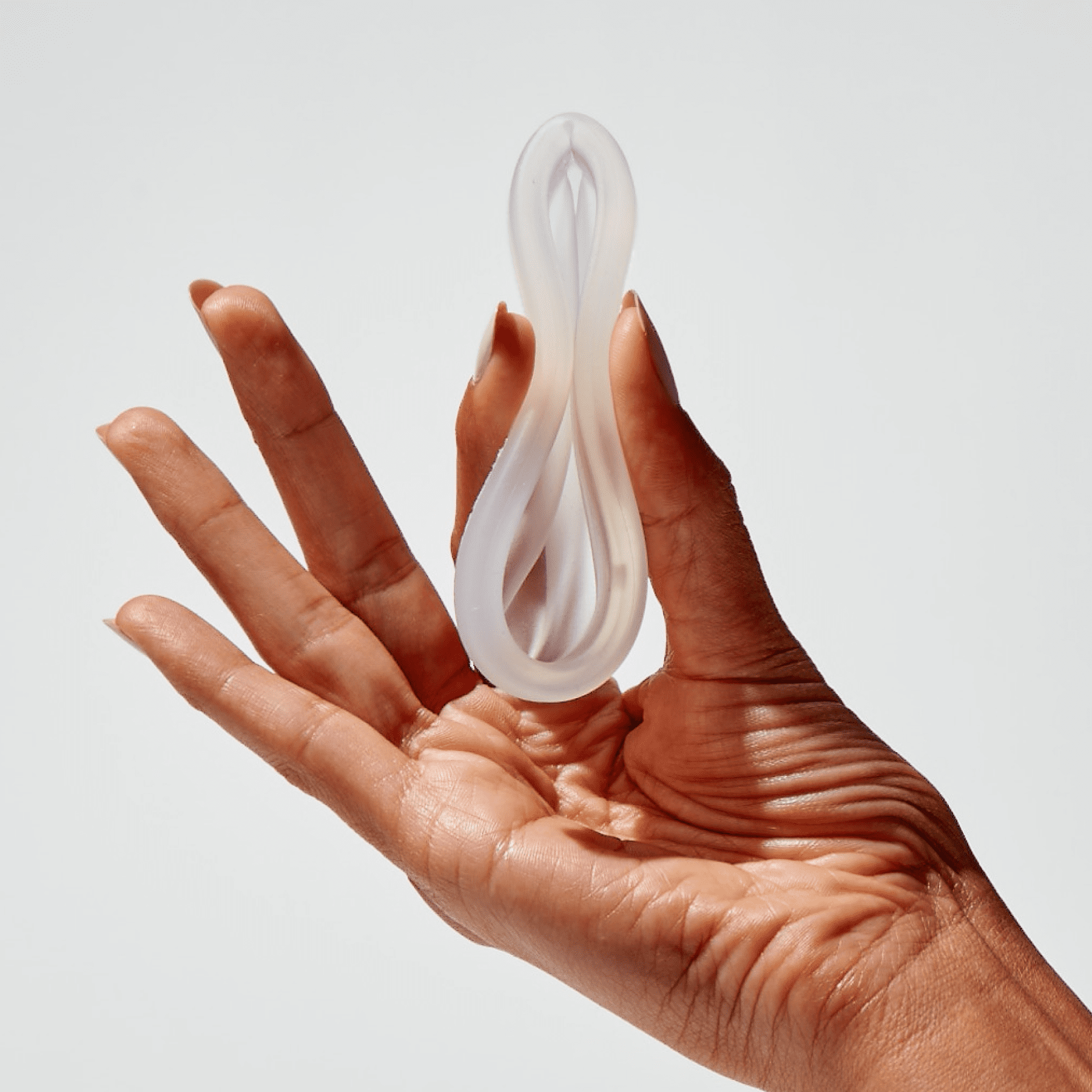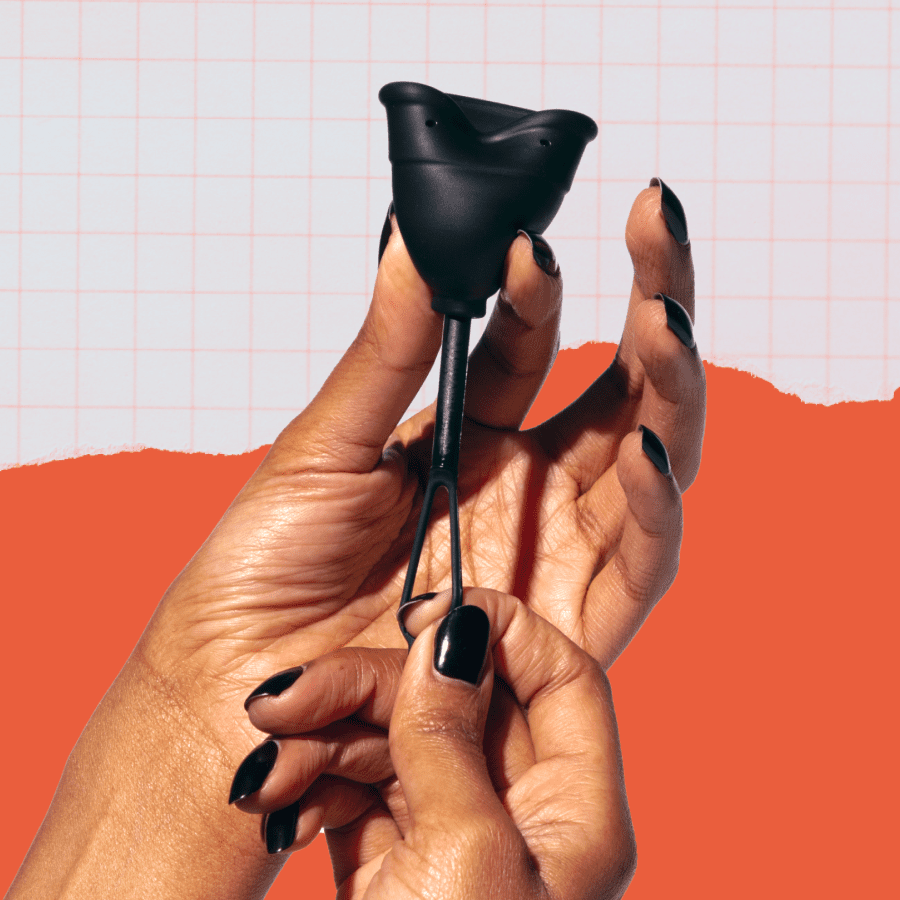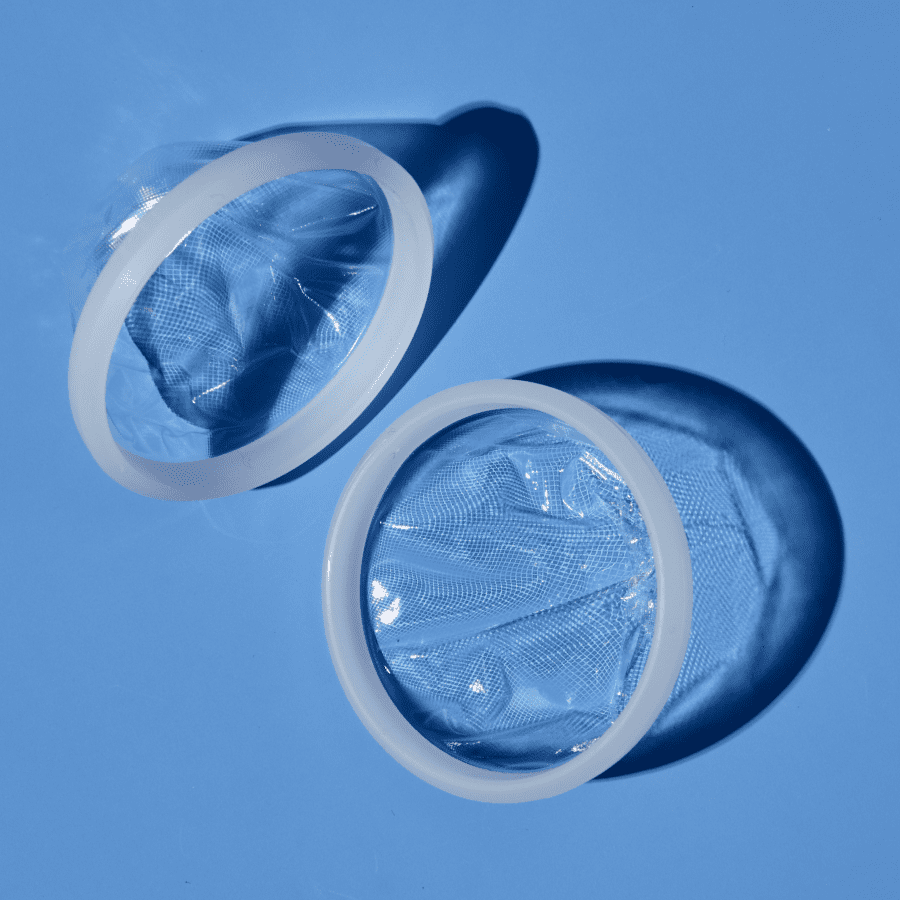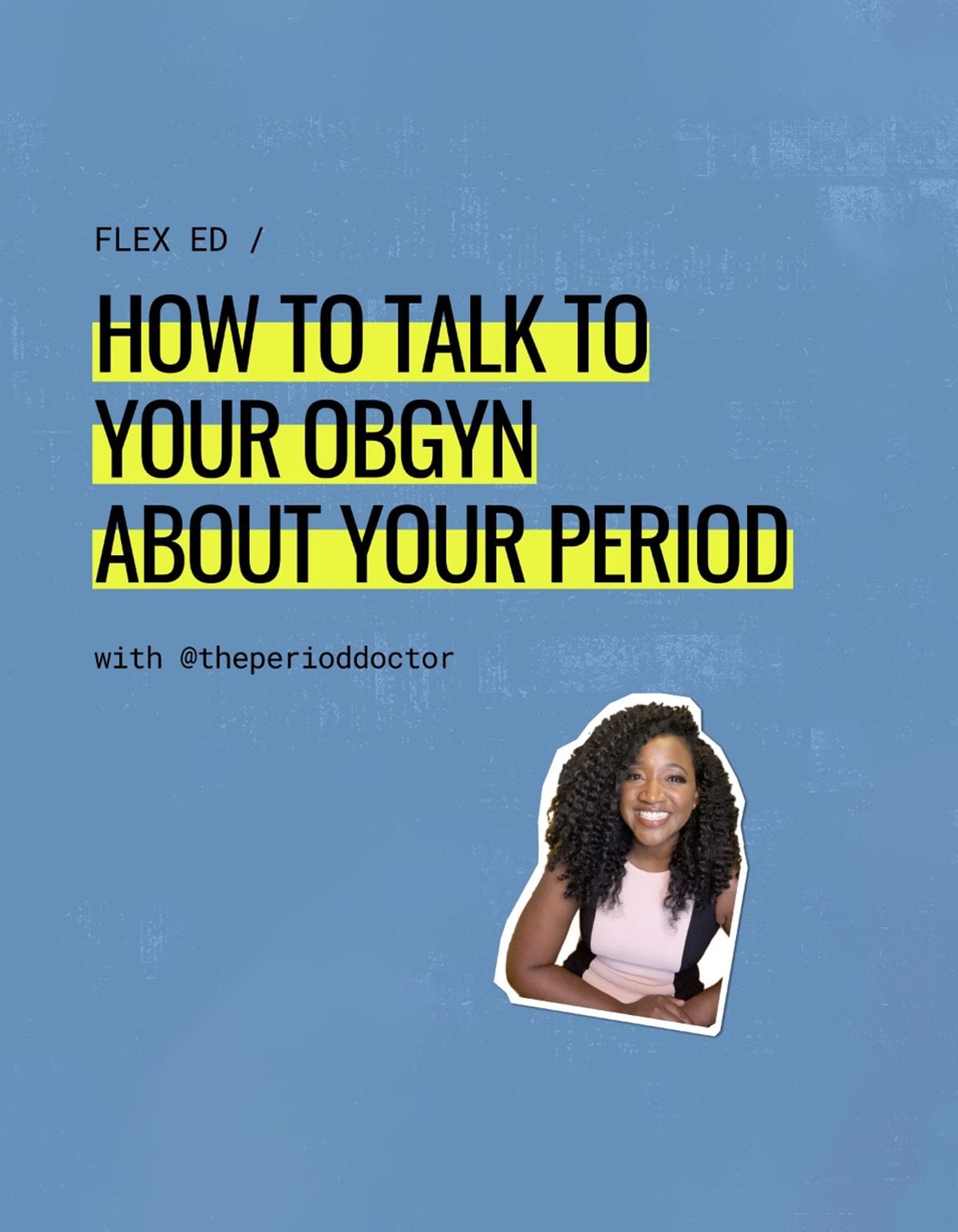Ever noticed how you’re super horny during a certain few days each month, and then not so much during another certain few days? Or that you suddenly sleep really well one week when the rest of the month you toss and turn?
Your hormones could have more to do with these changes than you might think. The menstrual cycle is a crazy thing, affecting everything from how much energy you have to your sleep habits to your food cravings and even your athletic endurance. And we’re not just talking about your period—we’re talking about the entire 28-day(ish) cycle.
There are four distinct phases of the menstrual cycle: menstruation, the follicular phase, ovulation, and the luteal phase. By paying closer attention to how your body feels during each phase, you can actually “hack” your cycle by planning around your anticipated mood and/or symptoms you typically experience.
It’s like unlocking a cheat code for real life.

A few examples:
- Want to make sure you schedule that big presentation when you’re feeling your sharpest? Try cycle tracking.
- Wishing you could schedule dates so that they align with when you’re feeling like your sexiest (and least bloated) self? Try cycle tracking.
- Trying to get pregnant…or trying not to get pregnant? Cycle tracking is your friend.
If you’ve been wondering how to track your period—or maybe you’re already tracking it, but want to level up—you’re in the right place. Read on for more.
The menstrual cycle phases
In case your high school sex ed classes have long since slipped from your memory, here’s a quick refresher on the menstrual cycle:
It has four distinct phases, beginning with the menstruation phase, which marks the start of a new cycle (AKA cycle day 1). Menstruation is technically part of the follicular phase, which makes up the first half of your cycle, more or less. For simplicity’s sake, we’ll refer to the follicular phase as phase two.
Then comes ovulation, our third “phase,” when the ovaries release an egg into the fallopian tubes. Ovulation occurs on a single day, so it’s not really a phase, but we’ll call it one (again for simplicity).
So long as that egg is not fertilized, you then enter the fourth and final phase, the luteal phase, which lasts for the remaining 10-15 days or so.
Keep in mind that the lengths of each phase will vary from person to person, as will the length of your overall cycle. The average is 28 days, but a “normal” menstrual cycle can range from 21 to 35 days, according to Mayo Clinic.
Take a look at the charts below for a visual of each phase:

| PHASE | DAYS (APPROX.) | WHAT HAPPENS |
| Menstrual (part of the follicular phase) | 1-5 | Estrogen and progesterone are at their lowest on the first day of your period (cycle day 1). |
| Follicular | 6–14 | Estrogen and progesterone are on the rise. |
| Ovulatory | 15-17 | Estrogen peaks. Testosterone and progesterone rise. |
| Luteal | 18-28 | Estrogen drops off, then rises slightly, and then drops off again. Progesterone rises up until about day 22, at which point it drops again in preparation for your period. |
Want to learn more about these hormones and how they prompt your body to ovulate, begin menstruating, and generally regulate your cycle? Read our deep dive into the menstrual cycle phases.
Different ways to track your cycle
1. The temperature method
Did you know that your basal body temperature changes throughout your menstrual cycle? For most people, their temperature before ovulation is between 96°-98°F. Right after ovulation, it goes up slightly to 97°-99°F. 1 By logging your temperature daily for a few months, you’ll start to see an upward trend in the middle of your cycle and should eventually be able to pinpoint your ovulation day.
Take your temperature at the same time each morning before getting out of bed, and as soon as possible after waking up. Meaning, right after the alarm goes off! Once you’ve been awake for more than a few minutes, your body temperature will start to fluctuate and will no longer count as your basal body temperature.
The most reliable and accurate type of thermometer for cycle tracking is an electronic one that you place under your tongue.
Keep a log of your basal body temperature in a journal or an app on your phone. When your temperature increases slightly, about half a degree, and stays elevated for three days or more, ovulation has likely occurred. 2 After ovulation, your temperature will continue to stay elevated for the remainder of your cycle.
There are several fertility awareness apps—most of which require a monthly subscription—that feature an algorithm that maps out these fluctuations for you. If you’re interested in a solution like this, check out Natural Cycles, Femometer, or TempDrop. Each of these apps will (fairly accurately) find your ovulation day once you’ve input your temperature for a certain number of consecutive days.
A note about the temperature method: If you are sick with a fever or hungover on any given morning, make sure to annotate that day’s recording or exclude it from your records altogether.
2. The cervical mucus method
Another way to track your cycle is by checking your cervical mucus, which is the formal term for vaginal discharge! Don’t worry, there’s nothing too complicated about it—but it does require that you get a little bit hands-on.
Chances are, you notice or come across cervical mucus almost every day. It’ll collect in your underwear or you might notice that it’s occasionally a bit slippery when you wipe with toilet paper. This is totally normal: As long as the discharge doesn’t have an unusual or noticeably foul odor, it’s a sign of good health.
The best way to check your cervical mucus when tracking your cycle is by using your index finger and thumb to collect some discharge from inside your vagina. Yes, it sounds weird, but we promise it’s super easy. Then, to check for color and consistency, you’ll gently rub and pull the discharge between your fingers.
Your cervical mucus should follow a pattern each cycle 3. It will look something like this:
- Days 1-5: Period blood, AKA menstrual fluid
- Days 5-8: Very little discharge; these are “dry days” (early follicular phase)
- Days 9-12: Discharge that is cloudy, white, and sticky, like the consistency of school glue; this is the time leading up to ovulation (your follicular phase)
- Days 13-17: Mucus will be clear and slippery, like the consistency of raw egg whites; this is the time right before and during ovulation when you are the most fertile
- Days 18-28: Mucus will turn white and sticky again and then start to decrease in quantity before your next period comes (this is your luteal phase)
Again, keep in mind that this is based on a 28-day cycle. If your menstrual cycle is shorter or longer, the days may vary a bit.
3. Using an app or journal
It can be helpful to use an app or journal in combination with the cycle tracking methods listed above, but if you know you won’t have time or remember to check your temperature or discharge on the reg, a journal alone is totally fine.
Decide whether you want to track on paper or using an app. If it’s the latter, you can check out our favorite cycle tracking apps in this article.
Keep the journal on your nightstand and pre-label the dates for the entire month. Try to get in the habit of recording daily entries either right when you wake up (if tracking temperature) or right before you go to bed. Each day, fill in the blanks for each of the following:
- Date
- Cycle day #
- Basal body temperature (optional)
- Physical symptoms
- Mental/emotional state
- Cervical mucus (discharge) color & consistency (optional)
- Random notes or thoughts
Your entry might look something like this:
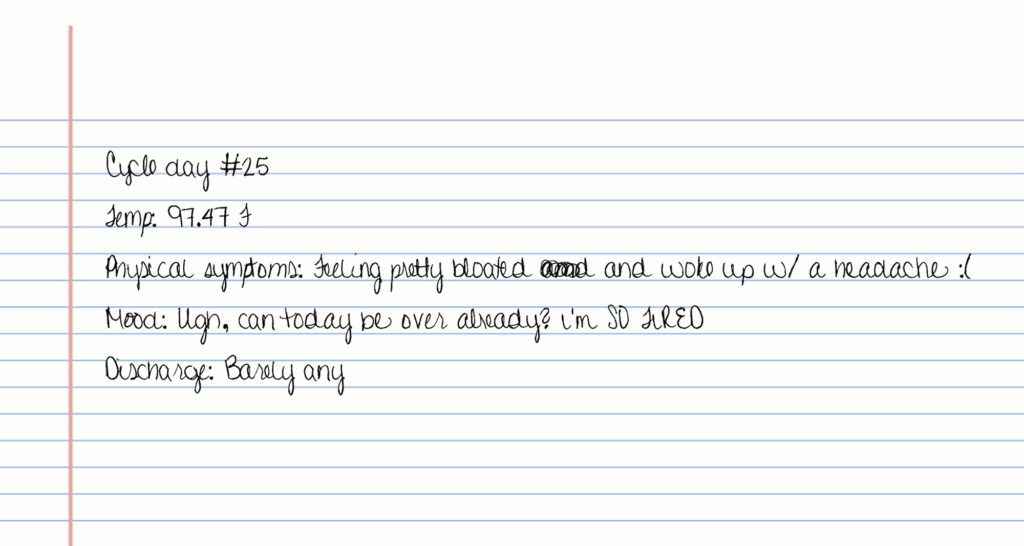
Every time you get your period, take a moment to look over your data from the month prior to record your cycle length, see if you noticed anything different or unusual, and take stock of how you’re feeling more generally. The first day of your period means that day’s entry will kick off a new month at cycle day #1.
Whether you use an app or a pen and paper to track your menstrual cycle, you’ll find that the notes you’ve taken come in handy especially during Ob/Gyn appointments—so don’t forget to bring them with you!
Can you track your cycle when you’re on birth control?
When you’re using a hormonal contraceptive like the birth control pill, patch, ring, shot, or hormonal IUD, your menstrual cycle will be fairly regular. This is because the contraceptive is regulating your hormone levels, usually via synthetic forms of estrogen or progesterone.
Note that you won’t have a “true” period when taking hormonal birth control. Instead, any bleeding you experience is known as breakthrough or withdrawal bleeding. Learn more about your period on birth control in this article.
Cycle tracking while on birth control is still totally worthwhile: It will help you keep an eye on changes that may occur over time, like a complete lack of bleeding (a fairly common effect of the hormonal IUD) or a sudden increase in spotting. It will also make it easier to keep tabs on your body if or when you do eventually decide to come off birth control.
For many people, coming off birth control can mean subsequent cycles may be fairly erratic for a short period of time. If you’re looking to avoid pregnancy, cycle tracking (in addition to barrier method contraception, like condoms) will help you figure out when you’re most fertile so you can avoid sex on those days and minimize your risk.
What you can learn from tracking your cycle
Many of us already track our periods. We know when our last period was and when it’s likely to come again (unless your periods are irregular, which we’ll talk about soon). But as we’ve learned, your period is only one phase of your cycle. It doesn’t show the whole picture.
At a minimum, tracking your period and your ovulation day will clue you in on whether your cycles are regular or irregular—as well as whether or not you’re ovulating. A lack of ovulation can point to underlying conditions like PCOS; delayed ovulation might also occur during prolonged periods of stress or due to a hormonal imbalance.
Here are some other simple things to look out for when cycle tracking:
- Note how long your period (the menstruation phase of your cycle) lasts and how much bleeding you have. If your period lasts for more than seven days or is unusually heavy, it could signal uterine-related problems, hormone imbalances, or bleeding disorders. 4 In this case, talk to a healthcare provider ASAP.
- Keep track of your overall cycle length, and look out for sudden changes from the norm. If your cycle lengths are very different each month, like one that’s 26 days followed by one that’s 45 days, talk to a healthcare provider. While some irregularity could be due to stress, travel, or even a cold or flu, irregular cycles can also point to underlying health conditions—such as primary ovarian insufficiency, PCOS, pelvic inflammatory disease, or an STI. 5
- Jot down how you’re feeling in your body each day, whether you’re tracking your cycle in an app or on paper. Try to do this at the same time every day, ideally right after you wake up in the morning. Note physical symptoms such as headaches or migraines, body aches, bloating, digestive discomfort, night sweats, breast tenderness, difficulty sleeping, or cramps.
- Take note of your mood and emotional state: Are you stressed or unusually anxious, but don’t know exactly why? Or are you feeling calm, confident, and ready to take on the day? What’s your sex drive feeling like, on a scale from 1 to WAP?
If you miss a period or notice your cycle length varies month to month, it’s important to contact your healthcare provider to see if there’s an underlying condition causing irregularity. Your healthcare provider may do an ultrasound or pelvic exam to see what’s going on. 6
How to plan around your menstrual cycle
When you start to consistently track your menstrual cycle, something magical will happen: You’ll realize you’re WAY more in tune with your body.
For instance, you might start to notice little changes that happen to your body around the same day each cycle—such as itchy nipples on day 26, a momentary twinge of stomach pain around day 14 (hello, ovulation), or having trouble waking up to your alarm on days 2 and 3.
The more detailed you can be with your daily journal entries, the better you’ll start to understand your body’s natural rhythms: When you’re feeling confident and energetic (like right after your period stops), when your sex drive is at its peak (the day before you ovulate, for example), and when your body most craves extra sleep and a less-hectic schedule (like right before your period).
Use all that intel to hack your calendar—social, work, and otherwise:
Menstruation
CYCLE DAYS 1-5, ON AVERAGE
Your period week is generally the week when you’ll have the least physical and mental energy to spare. However, keep in mind that menstruation is still technically part of the follicular phase—as the days go by and your flow gets lighter, your hormones start to pick back up again pretty quickly. Most menstruators feel the brunt of the period-related lethargy on days 1-3.
You may feel more aligned with your inner self, and potentially more clear-headed, during your period. Use this to your advantage by trying to practice mindfulness or further your meditation practice. It’ll be easier to listen to what your body wants—like fresh, nourishing foods and plenty of water—and you may be less inclined to put your job or school over your self-care (this is a good thing!).
Surprisingly, despite the fatigue, bloating, and other unpleasant physical symptoms, some menstruators report a boost in libido during their period. If your follicular phase is fairly short (i.e. you ovulate only a few days after your period ends), this could have to do with rising estrogen levels around days 6-10.
If this is you, know that period sex can be quite enjoyable—and orgasms can even reduce cramps! Turned off by the mess? No worries: Pop in a Flex Disc and have penetrative sex without worrying about staining your sheets. The disc is worn in the vaginal fornix, which leaves your vaginal canal free to explore. Yes, masturbation counts, too!

Some activities to consider for during the menstrual phase:
- Reboot your nightly stretching routine with some gentle yoga
- Get in some much-needed R&R by booking a massage, acupuncture, a mani/pedi, or a facial
- If you’re fairly uninhibited by your period, this could be a great time to take a solo vacation—but keep the itinerary at a leisurely pace
Follicular phase
CYCLE DAYS 6-14, ON AVERAGE
During the latter half of the follicular phase, once your period is over, your energy levels will begin to rise.
If your cycle phases were seasons, the follicular phase would be springtime: You’ll have renewed focus, a gradually increasing sex drive, and may feel more productive, outgoing, or more confident than you did the prior week.
The luteal phase is a great time to connect with friends, make an appearance at networking events, or go out on that Hinge date.
Other activities to consider scheduling during your luteal phase, especially cycle days 8-13, include:
- Cardio workouts, like jogging, spinning, or swimming—or try alternating between cardio and strength training
- Presentations for work/school, exams, or public speaking engagements
- Your wedding (okay, planning this far ahead to align with your cycle might be tough—but read more tips re: your wedding and your cycle here!)
Ovulatory phase
CYCLE DAYS 15-17, ON AVERAGE
Ovulation: For many, it’s the halfway point of the menstrual cycle. You’re still riding a high, rocking your hottest outfit, and feeling ready to take on the day. However, you might experience some mood swings and mild discomfort as your peaking estrogen levels suddenly dip slightly—and your progesterone levels ramp up—while your body releases an egg.
Breast tenderness and mild cramping or pain on one side of the pelvis (called mittelschmerz) is fairly common during ovulation, and is a sign that your ovary has done its job. 7 Any discomfort shouldn’t last long.
During ovulation, you’ll likely also notice wetter, egg white-like cervical mucus and an obvious peak in libido. This is the prime time for getting pregnant—so if you’re trying to avoid pregnancy, be sure to use condoms or another form of birth control.
What to schedule for around ovulation:
- Date nights with your partner—or a prospective partner
- Strenuous hikes, athletic competitions, HIIT workouts, strength training, or other high-intensity forms of exercise
- Day trips, parties, or get-togethers with friends
- That dream vacation to another city or country with lots of sightseeing
Luteal phase
CYCLE DAYS 18-28, ON AVERAGE
During the luteal phase, progesterone starts to take over as the dominant hormone. Progesterone, along with small amounts of estrogen, causes your uterine lining to thicken while it waits for a fertilized egg to stick. If no fertilized egg comes along, your body gears up for menstruation. Premenstrual syndrome (PMS) has entered the chat:
You’ll probably notice a gradual decline in your energy levels during the luteal phase, though this won’t usually happen until day 21 or thereabouts. Sluggishness or absentmindedness, mood swings, increased stress or anxiety, or unexplained sadness are all common emotional symptoms of PMS.
Why is this? It’s speculated to be linked to declining estrogen levels. Estrogen interacts with several brain chemicals that control your mood—in particular, serotonin, the “feel good hormone.” Studies have found that many menstruators experience a decline in serotonin during the latter half of the luteal phase. 8
To top it off, you may also experience physical symptoms like fatigue, bloating, sore or tender breasts, headaches, insomnia, cramping, food cravings, breakouts, and digestive discomfort.
During the luteal phase, consider:
- Taking a mental health day off from work, if you can (especially between days 24-28)
- Cozying up on the couch with a blanket—this is a great time to catch up on the new season of Euphoria
- Spending some time in the kitchen cooking up a favorite meal, especially if you can work in some serotonin-boosting ingredients like wild salmon, sweet potatoes, eggs, spinach, leafy greens, or fermented foods like kimchi
- Toning down your workout routine, especially right before your period (think yoga or pilates instead of HIIT)
Have more questions about cycle tracking? Send them our way! Email thefornix@flexfits.com or send us a DM on Instagram @flex.
This article is informational only and is not offered as medical advice, nor does it substitute for a consultation with your physician. If you have any gynecological/medical concerns or conditions, please consult your physician.
© 2022 The Flex Company. All Rights Reserved.
- Planned Parenthood. (n.d.). What’s the temperature method of FAMs? https://www.plannedparenthood.org/learn/birth-control/fertility-awareness/whats-temperature-method-fams[↩]
- Mayo Clinic Staff. (2021, March 03). Basal body temperature for natural family planning. Mayo Clinic. https://www.mayoclinic.org/tests-procedures/basal-body-temperature/about/pac-20393026[↩]
- Planned Parenthood. (n.d.). What’s the cervical mucus method of FAMs? https://www.plannedparenthood.org/learn/birth-control/fertility-awareness/whats-cervical-mucus-method-fams[↩]
- Centers for Disease Control and Prevention. (2017, December 20). Heavy menstrual bleeding. https://www.cdc.gov/ncbddd/blooddisorders/women/menorrhagia.html[↩]
- Mayo Clinic Staff. (2021, April 29). Menstrual cycle: What’s normal, what’s not. https://www.mayoclinic.org/healthy-lifestyle/womens-health/in-depth/menstrual-cycle/art-20047186[↩]
- UNC Healthcare. (2019, April 24). What cycle tracking can tell you about your health. UNC Health Talk. https://healthtalk.unchealthcare.org/what-cycle-tracking-can-tell-you-about-your-health/[↩]
- American Pregnancy Association. (n.d.). Ovulation symptoms. American Pregnancy Association. https://americanpregnancy.org/getting-pregnant/infertility/signs-of-ovulation/[↩]
- Rapkin, A. J., & Akopians, A. L. (2012). Pathophysiology of premenstrual syndrome and premenstrual dysphoric disorder. Menopause international, 18(2), 52–59. https://doi.org/10.1258/mi.2012.012014[↩]


